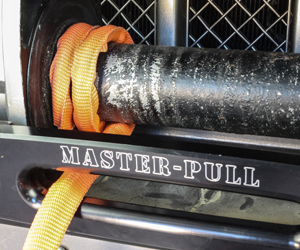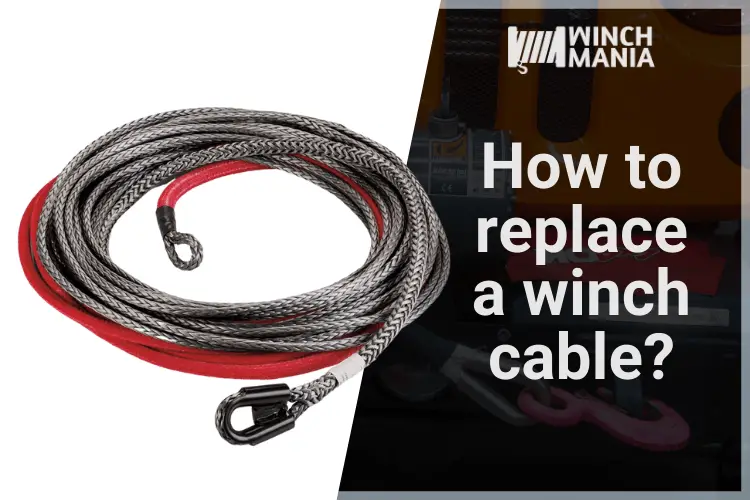
Among all of the accessories of a winch, perhaps the most important is the winch cable or rope. The winch cable is the part that gets exposed all of the time. It is also the part that experiences the most tension during a pull.
Due to its importance, you might decide to get a winch cable that is of a better quality than the one you currently have. Or maybe your winch cable has already been showing signs of damage and you do not want to use it again for fear of an accident. Even if these two scenarios do not apply to you, you can still benefit in learning how to replace a winch cable. This is a skill that all off road enthusiasts and winch users alike need to learn.
But before anything else, you first have to decide what kind of winch cable to use. If you are yet undecided on using whether a steel wire cable or a synthetic rope, read this detailed article. It is particularly helpful.
At a Glance
How to Replace a Winch Cable Part 1: Removing the Installed Cable
The first step in replacing your winch cable is uninstalling the cable already installed in the winch.
Important Note: Always wear a pair of good quality tough gloves when handling winch cables.
- Remove the coverings on the winch drum. Some winch models have coverings around the winch drum. You have to remove them; you have to expose the entire winch drum in order to see what you are working with. These protective covers may be metal plates or bars.
Don’t remove the winch drum from the rest of the winch. You will still need the motor attached to the drum in later stages of the process.
- Disengage the clutch. Release the drum and put it on free spooling mode.
- Pull the winch cable out. Now that the clutch is in free spooling mode, you easily pull the cable out. Pull the entirety of it out until you reach the end of it that is attached to the drum.
- Detach the cable from the drum. There are two primary ways in which a winch cable is attached to the winch drum. Depending on the material of your cable or on how the manufacturers of the winch designed it, you can have the cable either tied on the winch drum or locked on it by a bore and a bolt.
You have to remember exactly how the preinstalled cable is attached to the winch drum. You will have to install the replacement cable in the exact same way the previous cable was installed. Taking pictures of how the preinstalled cable was attached helps a lot.
How to Replace a Winch Cable Part 2: Installing the New Cable
- Smoothen the drum. Winch cables tend to fray and kink when used over time. This is especially true of steel wire cables. These kinks and frays can damage the surface of the winch drum, making it rough. Before you attempt to put the new cable on the drum, sand the burrs and sharp edges on the drum. Sand it to total smoothness. This will ensure that the new cable will not get damaged unnecessarily.
Optional: Get a new fairlead. If you were using a synthetic rope, and are now replacing it with a steel wire cable, you might want to change the fairlead to a more suitable one, namely a cast steel fairlead. If you were using a steel cable and a cast steel fairlead, you might want to switch to a roller fairlead if you are switching to a synthetic rope.
Make sure that there is enough room for the cable between the drum and the fairlead. Having a sufficient enough room between the drum and the fairlead lessens the potential damage on the winch cable during pulls. If the fairlead is too close to the drum, the cable will be pulled at a steeper angle than necessary, which can damage it.
Also make sure that there is enough free space between the fairlead and the montage plates. If they are too close together, the winch cable may be damaged by the sharp edges of the plate. A space of at least half an inch should suffice.
Check this guide for more info on fairleads.
- Attach the winch line. If you have taken the care of remembering how the old cable was attached on the drum, this step should be nothing but a breeze. Just replicate the old cable’s attachment on the drum with your replacement cable.
Some cables have an overheat protective sleeve. If you do not have one, it is advisable that you get one, they are very useful and practical. They also don’t cost much. It is recommended that you place this sleeve on the end of the cable attached to the drum. This will protect the cable from being damaged by the heat generated by the winch drum during a winching operation.
- Spooling the winch line. You can start spooling your new winch cable once it is absolutely and securely attached to the drum. To make the process easier, do not do this manually. Instead, turn the winch on and use the remote control to make the winch pull the cable towards itself.
It is ideal to have an assistant at this point to help you. While the winch is slowly pulling the cable to itself, guide the cable with your gloved hands. Make sure that it is wrapped neatly and evenly around the drum.
Make sure that you have a complete layer of winch cable around the drum, from one side to the other, before overlapping it on top of itself. Make sure that the cable is tightly wrapped around the drum to maximize the space around the drum and to also effectively utilize the friction generated by the machine during a pull. While keeping these pointers in mind, guide the cable from side to side and back again and again until you have the entire length of the winch cable wrapped around the drum.
Every time you use your winch, you have to re-spool the cable to make sure that it is ready for the next emergency pulling.
Done! You have now successfully replaced your winch cable! You just have to put the covers around the drum again, if there were any.
Best Winch Cable Replacements: Our Recommendations
Replacing your old winch cable is a pretty much useless endeavor if the replacement cable is a piece of trash that will not last two seconds. To help you pick a good quality cable, here are our recommendations of the best cable replacements.
- Fulton WC325 0100
- Ucreative Synthetic Winch Line U-WL-156B
- FieryRed Synthetic Winch Rope
- B/A Products 4-38PS50LH Steel Winch Cable
- HOOAI Synthetic Winch Rope
Hopefully this guide has been helpful for you. If you have any questions or comments about the topic, just write them down on the comments section below! We love hearing from you.

